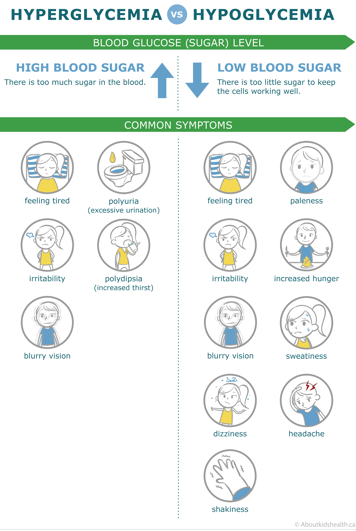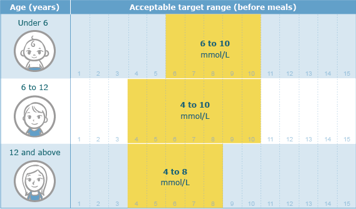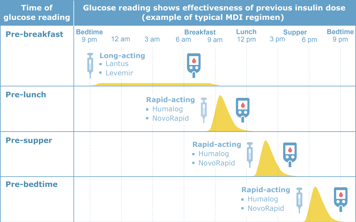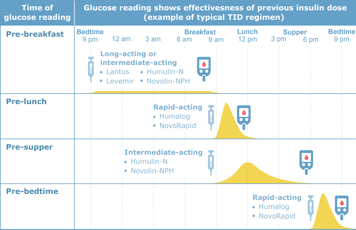Glucose (sugar) travels in the bloodstream to reach different cells in the body along with other nutrients. Just after a meal, blood sugar levels rise. Between meals, after vigorous exercise, or after a long period without food, (such as before breakfast), blood sugar levels are at their lowest. Checking blood sugar levels is the best way to tell how well your child is balancing their insulin, sugar from food and exercise.
What is a blood sugar target range?
Blood sugar is measured in millimoles of sugar per liter of blood (mmol/L). If someone without diabetes measured their blood sugar levels before breakfast (fasting blood sugar levels) and after eating, they would have the following results:
| Blood sugar levels in children without diabetes | |
|---|---|
| Before breakfast (fasting) | After breakfast (sugar levels rise) |
| 3.3 to 6 mmol/L | 8.9 to 11.1 mmol/L maximum |
An example of a target range could be 6 to 10 mmol/L
| Example: Target range is 6 to 10 mmol/L | |
|---|---|
| At target (inside the range) | Off target (outside the range) |
| 6 mmol/L | 5 mmol/L (too low) |
| 8 mmol/L | 11 mmol/L (too high) |
Hyperglycemia (high blood sugar) and hypoglycemia (low blood sugar)
Keeping your child’s blood sugar levels within its target range helps your child stay healthy. If blood sugar levels go too high or too low, your child will experience unpleasant symptoms associated with hypoglycemia and hyperglycemia:

For children with diabetes, the key to balancing blood sugar levels is to match their insulin intake with the amount of food they eat and their level of physical activity.
Blood sugar target range
Blood sugar targets change as your child grows. Target ranges are set by your child’s ability (and your own) to understand diabetes, interpret signs and feelings of low blood sugar levels, and act on them. They are worked out with the diabetes team, and everyone on the team should have the same goals.

It is expected that after-meal blood sugar levels will be higher; this is known as post-prandial hyperglycemia. Blood sugars should return to target range four hours after the meal.
Monitoring and record-keeping
It is a good idea to check blood sugar levels before meals. These readings provide the most useful information for evaluating the effectiveness of insulin doses. Each blood sugar check gives a unique and important piece of information depending on the type of insulin taken and the insulin regimen used (for example multiple daily injections (MDI) versus three times a day (TID) regimen ).
For example, for those who are on a typical MDI regimen (rapid-acting insulin before every meal and long-acting insulin once daily), here is what each reading tells you:

For those on a typical TID regimen (short and intermediate-acting insulin at breakfast, rapid-acting insulin at supper and long-acting or intermediate acting insulin in the evening or at bedtime), here is what each reading tells you:

Blood sugar testing four times a day is ideal but may be a challenge. For example, a lunchtime check for young children in daycare or school may be difficult, and parental, teacher, or community nurse support will be needed. You will need to negotiate this with the staff at your child’s school or daycare.
While older school-age children may find lunchtime tests inconvenient, you should encourage them to do so.
When to do extra checking
Sometimes blood sugar levels should be checked outside routine times. Here are some situations in which a child should do extra testing:
- before, during and after a lot of exercise, such as dance classes or soccer practice
- if symptoms of low blood sugar (hypoglycemia) are present
- every four hours during an illness (during illness,
ketones should be checked along with blood sugar levels)
- at other times prescribed by the diabetes team, or when trying to problem-solve or gather information about the impact of a certain food or activity
- in the middle of the night if low blood sugar signs and symptoms are present, to help detect if your child or teen is having late-night blood sugar low events.